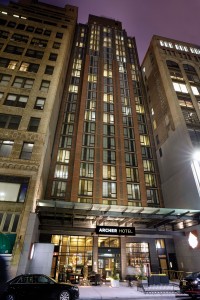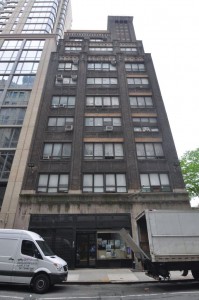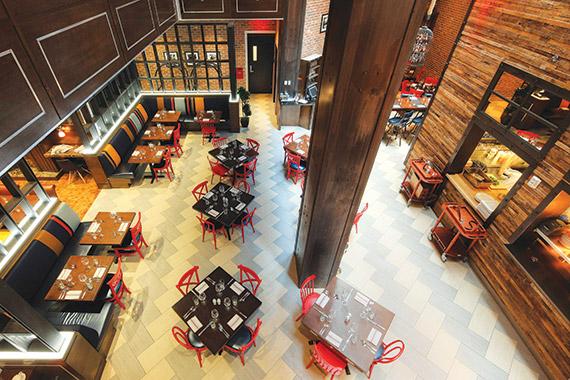An alteration that has nothing to do with hemlines could bring another wave of changes to Manhattan’s Garment District.
While the area has seen an influx of hotels in the last decade, the city is now considering zoning changes that would remove restrictions on landlords, so they can rent their buildings entirely to office tenants.
Potential tailoring to the Garment District’s current zoning, which the Department of City Planning is reviewing, would undoubtedly accelerate an about-face that’s already underway.
Steven Kaufmann, president of the Kaufman Organization, which owns several office properties in the Garment District, said a rezoning would “increase property values and tax revenues for the city.”
Some argue that the city should get rid of a 1987 regulation that requires a large portion of the space in the area to be set aside for manufacturing use. But a more moderate plan is also being pushed to preserve some of the manufacturing in certain areas, while expanding the types of allowable commercial uses in others.
Opening the floodgates for residential development, however, is not likely to be on the table, said Ira Fishman, CEO of EVO Real Estate Group and a board member of the Garment District Alliance, a non-profit funded by the area’s property and business owners .
“Over the last five to 10 years, city officials have said in meetings with The Garment District Alliance that they don’t want residential in that area. They want to keep it strictly a commercial area, because it’s in the heart of Midtown,” said Fishman. “They gave us residential zoning between Eighth and Ninth avenues, but Fifth Avenue to Seventh Avenue should be commercial.”
Still, looser commercial zoning requirements would drive up office rents, which have at least doubled in the last 15 years, as well as help improve the retail in the area, said Jeff Nissani, associate broker at Marcus & Millichap. (The latest retailer to announce plans to join the fray is the ever-popular Shake Shack, which is scheduled to open in the fall at 1333 Broadway.)
But while a rezoning would be a boon to landlords and investors, sources say it could deliver the final blow to the industry that gave the neighborhood its name.
“We will lose experienced manufacturers and it will jeopardize the present trend of the fashion industry coming back to the U.S.,” said Samanta Cortes, one of the co-founders of Save the Garment Center, which was formed in 2007 to advocate for preserving the district’s manufacturing status. “It’s not that U.S. manufacturing solely depends on the New York City Garment Center, but the initial prototypes and high-end manufacturing is based in New York, and it’s considered the backbone of the industry.”

The Garment District in the 1950s
A partial transformation
In the last decade, the area, which runs from Fifth to Ninth avenues and from 34th to 42nd streets, has seen 30 new hotels, and there are 10 more in the immediate pipeline. Those hotels, which include trendy hotspots like Refinery and the Strand, have played a big role in turning the area into a hip destination, particularly for tourists.
“It’s a 24/7 neighborhood with a multitude of businesses, tremendous retail and phenomenal hotels and restaurants,” said the CEO of the Handler Real Estate Organization, Scott Galin, who has had a 30-year presence in the neighborhood. “There was a time not that long ago when it was strictly a business district, which would be dead at the end of the workday.”

The Archer Hotel
Stephen Goglia, CEO of the David Burke Group, which in May opened the restaurant Fabrick in the Archer Hotel at 45 West 38th Street, echoed that point.
“Hotels bring people back into a neighborhood. For breakfast, we have hotel guests and people meeting for business,” he said, noting the eatery’s name was meant to pay homage to the district’s history. “We see people working in the community come in for lunch and on weekends.”
In addition to the celebrity-chef cache at Fabrick, many of the new hotels in the area include rooftop bars and lounges that have helped change the neighborhood’s image.
But only 12 new residential buildings, including Glenwood’s luxury rentals Emerald Green and Crystal Green, have risen in the Garment District and they are all on the western edge of the neighborhood, which was partially included in the sweeping 2005 rezoning of the abutting Hudson Yards area. That rezoning allowed buildings smaller than 70,000 square feet to be converted to residential or hotel use, and also allowed for teardowns.
Tapping tech
In addition to the hotel development, the Garment District is attracting so-called “TAMI” businesses — those in technology, advertising, media and information — because of its relatively affordable rents and large stock of Class B and C office buildings.
“When Flatiron and Chelsea became too expensive, you saw a push northward into the Garment District from creative tenants,” said Marcus & Millichap’s Nissani.
Asking rents in the area just south of Times Square, the hub of the remaining garment industry, — were $51.74 per square foot in 2014’s fourth quarter, according to the commercial firm Newmark Grubb Knight Frank. That was the lowest in Midtown and Midtown South.
By comparison, rents average close to $58 per square foot in Chelsea and $62 in Flatiron.
And some have locked in leases at even lower rates.
The search engine firm Elite SEM signed a seven-year, 7,160-square-foot lease last year at 142 West 36th Street, where the database CoStar Group shows that the asking rent on the deal was $44.50 per square foot. That’s the same building that commercial real estate tech company View the Space moved into earlier last year. And, in the biggest coup, Amazon signed a 17-year lease in November for 470,000 square feet at 7 West 34th Street, on the southeastern border of the neighborhood, where rents start at $62.80 per square foot, Vornado Realty Trust said in public filings earlier this year.
“You have close proximity to Penn Station, Grand Central Station and Port Authority,” said Handler’s Galin. “So, relocating your business here means you can have employees located in Westchester, Long Island, or New Jersey. That’s a giant selling point.”
Property owners are anxiously awaiting a move from the chairman of the City Planning Commission, Carl Weisbrod, who late last year reportedly told neighborhood stakeholders that he would address the rezoning “in the first quarter of 2015.”
Kaufmann told TRD his firm considered selling 132 West 36th Street, an office building, last year, but despite strong interest decided to hold off because values were going up “significantly” and would continue to accelerate if a rezoning is greenlit.
Kaufmann also said that a rezoning would “legalize all these office uses that are taking place anyway,” noting that the zoning regulations aren’t strictly enforced.
According to the news site Capital New York, a spokesperson for the city’s Department of City Planning called the district’s zoning “obsolete,” and noted that it was “not serving the interests of tenants, manufacturers, the fashion industry or property owners.”
“We’re committed to working with all interested parties to explore solutions to this land use dilemma,” the City Planning spokesperson said. “Saying it’s complicated is an understatement and … a solution will take time and a willingness to compromise.” Pressed for further details, the agency would say only, “We will let the public know when we have something further to put on the table.”
The issue has been brewing for a while.
In the early 1930s, the Garment District boasted the largest concentration of clothing manufacturers in the world. But production began to move out of state after World War II and then, eventually, overseas. In 1950, the fashion industry represented 13.5 percent of the city’s employment. In 2012, the most recent figures available, that figure was barely over 1 percent.
To stem the outflow of fashion-related manufacturing jobs, the city enacted a special zoning regulation in 1987 that compelled Garment District landlords to reserve half of their property space for manufacturing purposes. But sources said that it did little to achieve that goal largely because manufacturing continued to move overseas where production was cheaper.

338 340 West 39th Street
“The district lost production after the zoning at the same rate as before the zoning regulation,” said Barbara Blair Randall, president of the Garment District Alliance, the area’s business improvement district, which has been lobbying the city on the zoning changes.
From 1995 to 2012, fashion industry employment in the 10018 Zip Code that encompasses the Garment District fell by 44 percent, while non-fashion employment rose by 82 percent.
Many in the fashion industry are pushing back against the changes, including high-profile fashion designers Nanette Lepore and Anna Sui.
“Right now, there’s a big trend toward ‘made in the U.S.A.’ after the factory fires in Bangladesh, so production is coming back,” said Cortes of Save the Garment Center. “The clustering of manufacturing and designers makes collaboration more efficient. It’s crucial to have it all together.”
In 2013, after her rent doubled, Cortes shuttered her business, Fashion Design Concepts, which developed embroidered, embellished and beaded apparel samples and was located at 338 West 39th Street. The combination of the aftermath of the recession and the rent hike did her in.
“I couldn’t recover,” she said.
In January, Sam Chang’s McSam Hotel Group acquired that building for $22.5 million.
